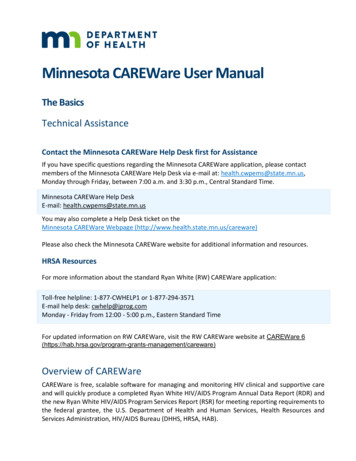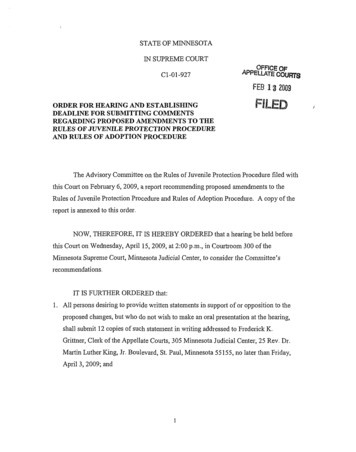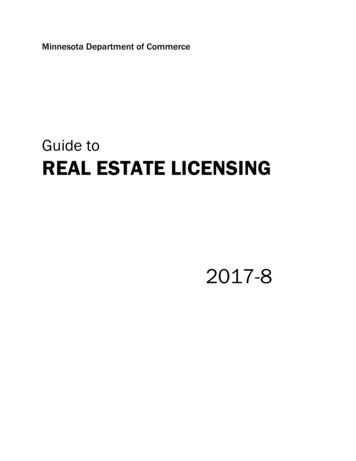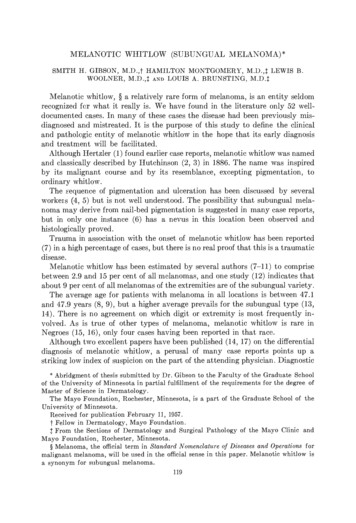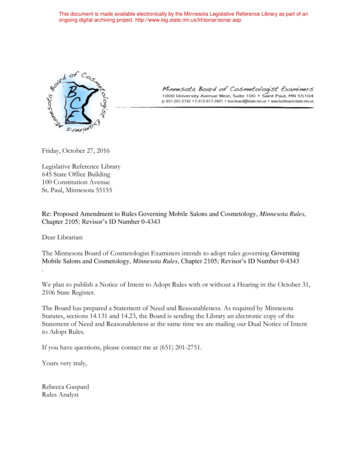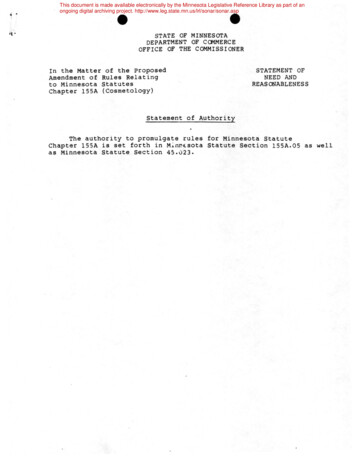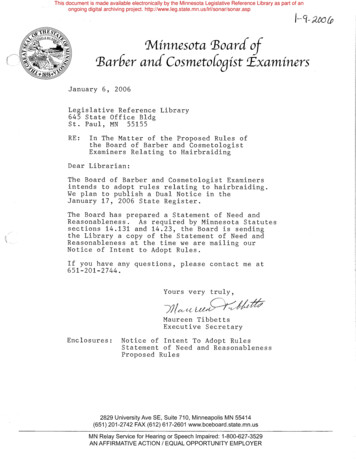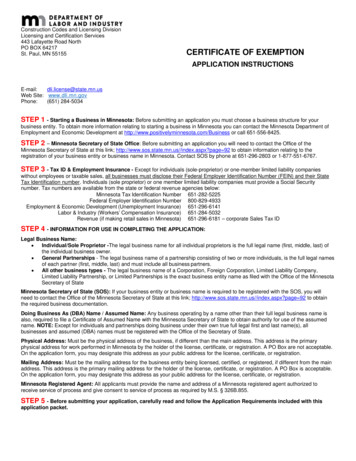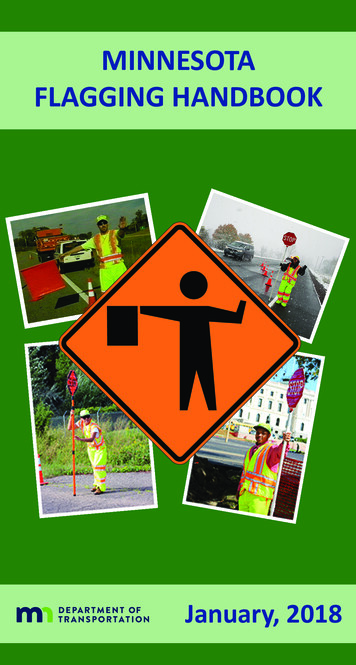
Transcription
MINNESOTAFLAGGING HANDBOOKJanuary, 2018
This Flagging Handbook has been developedfollowing the guidelines of the 2011 edition ofthe Minnesota Manual on Uniform Traffic ControlDevices, including its latest update.According to Minnesota Statute 169.06, Subd. 4(e),a flagger is permitted to stop and hold traffic asnecessary to ensure the safety of highway workersand the motoring public.No job is so importantin maintenance orconstruction, andno service sourgent, that wecannot take timeto perform ourwork safely.The Flagging Handbook as well as the Field Manualand other documents are available on the MnDOTTraffic Engineering website:www.dot.state.mn.us/trafficeng
INTRODUCTIONTo You, the Flagger:REMEMBER - Your job is the most important one onthe crew. The lives of all individuals in and travelingthrough the work space depend on YOU!Every flagger should be trained in flaggingoperations. Check with the road authority for trainingrequirements. This Handbook will give you basicguidelines regarding flagging operations. Familiarizeyourself with these procedures. If you have anyquestions or concerns, don’t hesitate to ask yoursupervisor.For your personal safety as a flagger NEVER fully turnyour back to or stand in the path of moving traffic.EQUIPMENTClothingFlaggers shall wear high-visibility clothing meetingANSI/ISEA 107-2004 (or ANSI/ISEA 107-2010)Performance Class 3 requirements. ANSI/ISEA 1072015 Type R, Performance Class 3 is also acceptable.The Class 3 requirements shall be met by wearinga Class 2 or Class 3 vest, shirt, or jacket; as wellas Class E pants. Clothing shall have an attachedoriginal label indicating the Performance Class. Clothing background color shall be fluorescentorange-red, fluorescent yellow-green, or acombination of the two. Retroreflective material on the clothing shall beorange, yellow, white, silver, yellow-green, or afluorescent version of these colors. The materialshall be visible at a minimum distance of 1000feet. The vest, shirt, or jacket shall be worn such that360 degree visibility in a horizontal plane of theclothing is maintained. A retroreflective hat in the above colors should beworn. A retroreflective wrist band in the above colorsmay be used. The wrist band helps differentiatethe flagger from work zone devices.1
A neat appearance and clean clothing shall bemaintained in order to help command respect ofthe drivers.Tools Standard STOP/SLOW(W21-X7) paddle shall beused unless it is not availablein an emergency situation oras otherwise specified in thisHandbook.--18 x 18 inch minimum octagonwith legible letters at least 6inches high.--5 foot minimum staff (to the bottom of the sign), 7foot is recommended.--Fully retroreflectorized in standard colors withminimal abrasions or fading. Two-way communication devices should be usedfor multiple flagger situations. A 24 x 24 inch fluorescent red/orange flag orretroreflective red flag to be used only in anemergency or at an intersection. Flashlight with red glow cone may be used:--to supplement the STOP/SLOW paddle at night,--at intersections, and/or--for emergency situations.Flagger stations shall be illuminated at night exceptin emergency situations.2
FLAGGING POSITION Be alert, remain standing at all times. Face traffic approaching the work zone. NEVERfully turn your back to traffic or stand in the path ofany moving vehicle (see Figure 1). A flagger’s normal station is on the shoulder of theroad. Always have an escape route. Park your vehicle off the road and away from yourstation in order to maintain an escape route and tonot be obscured by your vehicle. Stand alone, donot mingle with the work crew or the public. Make sure you are visible to oncomingapproaching traffic. Consider not standing wherethe sun is impeding visibility or in a shadow. Stand in a location that allows approaching trafficadequate time to respond. Use the Decision SightDistance (D) in the following chart to determinea location with good visibility. The driver must beable to recognize you as a flagger for at least theDecision Sight Distance (D). Make sure YOU can see approaching traffic forthe length of the Decision Sight Distance (D).Decision Sight Distance (D)Posted Speed(mph)Decision SightDistance(feet)0 - 3055035 - 4070045 - 5090055120060 - 65140070 - 7516003
Figure 1: Preferred Flagging PositionFLAGGING APPLICATIONSPrior to the start of flagging operations, all signingshall be inplace. A good visibility location is onewhere the sight distance is sufficient and the flaggeris clearly visible to approaching motorists.When the temporary traffic control zone covers a longsegment of highway, additional flagger signs maybe needed. In high speed areas, the maximumdistance from the last sign to the flagger shall notexceed 1 mile. In low speed areas consider reducingthe spacing between the flagger and flagger aheadsign to ½ mile or less.When more than one flagger is being used, allcommunication procedures should be clear beforeany flagging begins. If there is a roadway intersectionwithin the flagged area, an additional flagger(s) maybe needed to control traffic entering the temporarytraffic control zone from the roadway intersection.4
PostedSpeed LimitPrior to t)(B)DecisionSightDistance(feet)(D)0 - 301002520055035 - 403252530570045 - 50600504259005575050500120060 - 65100050650140070 - 751200508201600additional required* Forsigns, see appropriate*Alayout in the Field Manual.Minimum to 1 MileMaximum①100 feet②- Channelizing Device2GB②①A Minimum to 1 Mile Maximum*Notes①① The approach sight distance to the flagger shall be at leastthe Decision Sight Distance (D) .②② The two-way taper should be 50 feet using 5 equally spacedchannelizing devices.Figure 2: Flagger Location for a Lane Closure5
Traffic queuing over long distances due to flaggingoperations may cause potentially dangeroussituations. These situations may include traffic backedup through an intersection, up an exit ramp onto afreeway, or stopped prior to the first warning signs.When the flagger observes any of these occurring,they should immediately notify their supervisor. Theflagger may be given instructions on how to helpmaintain a shorter backup of vehicles.Single FlaggerThere are three different applications of the singleflagger situation.1) Temporarily stopping and directing trafficacross the center line.On an intermediate volume road (less than 1500ADT) with good visibility, a single flagger maybe used to control one direction of traffic whilethe other direction flows free. In this situation,the flagger is positioned in the closed lane atthe beginning of the taper. The flagger stops thetraffic approaching in the closed lane. When theopen lane is clear, the flagger allows traffic toproceed. If the Decision Sight Distance (D) is notavailable beyond the work space for the flaggerto detect oncoming traffic, two flaggers shall beused. Two flaggers may also be required duringhigh peak traffic periods or if there is a majorintersection near the activity area.2) Temporarily stopping and releasing traffic inthe same lane.A single flagger may also be used to stop trafficin a lane while that lane is temporarily closed.An example would be a truck depositing materialoff the edge of the roadway. In this situation,the flagger would stop traffic in the lane beingblocked by the truck while the other lane flowsfree. When the lane is no longer blocked, theflagger would allow traffic to proceed. Afterstopped traffic is allowed to proceed, the flaggershould turn the flagger paddle parallel to trafficso that no message is displayed to eitherdirection of traffic.6
3) Intersections.For flagging intersections see the “IntersectionFlagging” section in this Handbook.Two FlaggersWhen two flaggers are required, lines ofcommunication must be established prior to the startof flagging operations. The two flaggers must be ableto see each other or have two-way communicationdevices designated for proper communication. Oneflagger SHALL be the lead flagger and coordinate allactivities.Figure 3: Two Flagger OperationAn effective method to ensure that traffic from theopposite direction is not released prematurely is theflag transfer. A flagger gives the driver of the lastvehicle proceeding into the one lane section a flag (orother token object) and instructs the driver to deliverit to the flagger at the other end. The opposite flaggerthen knows that it is safe to allow traffic to move inthe other direction. The flag (or token object) beingcarried should always be clean and dry.7
Flagging with a Pilot CarTwo (or more) flaggers may also be used inconjunction with a Pilot Car, which is a speciallymarked vehicle that leads motorists through a workzone. In this application, the flagger stops traffic untilthe Pilot Car has pulled into position to lead trafficthrough or around the activity area. The flagger thenreleases traffic to follow the Pilot Car. When a largegap in traffic or a predetermined length of time occurs(as instructed by the supervisor) traffic is stopped.During Pilot Car operations, traffic should followthe Pilot Car and remain in a tight group to preventtraffic from separating along the route. A Pilot Car isan effective method of regulating the speed of trafficthrough the work zone. To help keep the traffic grouptight, flaggers should not allow additional vehicles tofollow the group if the last vehicle in the group hasproceeded more than 300 feet from the flagginglocation. The flagger shall then stop and hold alltraffic until the Pilot Car has returned for the next trip.P I L O T CA RFOLLOW MEFigure 4: Use of a Pilot VehicleAdvance FlaggerConsider using an advance flagger where there islimited sight distance to the activity area or wherelong lines of traffic form. In a situation such as limitedsight distance, the advance flagger should stop eachvehicle and inform the driver of the situation ahead.Where there are long lines of stopped traffic waitingto proceed, the advance flagger should move downthe line and inform each driver of the reason for thedelay and the approximate length of the delay.8
Intersection FlaggingOnly a licensed uniformed law enforcement officerhas the authority to override a fully operating trafficcontrol signal system (operating through the green,yellow, red cycle). When traffic signals are set to flashred for all approaches, or turned off and temporarySTOP signs are installed, the intersection may betreated as a non-signalized intersection. A flaggingoperation within a non-signalized intersection mayoverride STOP and YIELD signs in the intersection.Approval from the road authority shall be acquiredprior to placing signals into red flash mode or turningsignals off.When flagging within an intersection, consider thefollowing: High-volume intersections, large intersections,roundabouts, or complicated situations mayrequire additional flaggers. When multipleflaggers are used, a lead flagger shall bedesignated to coordinate flagging operations. The flagger(s) should use hand signals with a flagor flashlight with red glow cone to control trafficmovements rather than the typical STOP/SLOWpaddle. The flagger(s) may direct vehicles to proceedthrough a STOP sign controlled condition whileholding traffic on other approaches. Although theflagger may urge motorists to continue throughthe STOP sign, the flagger has no authority toprevent traffic from stopping and must allow forstopping within the operation. The flagger(s) should be aware of trafficconditions at adjacent intersections andcoordinate operations to minimize traffic backupsand conflicts.Automated Flagger Assistance Devices (AFADs)When using AFADs, see MN MUTCD (mndot.gov/mnmutcd) Sections 6E.4 through 6E.6.Automated Flagger Assistance Devices (AFADs)enable the operator to be positioned out of the laneof traffic and are used to control road users throughtemporary, one-lane, two-way traffic control zones.9
They can be remotely operated by one operator at acentral location or by separate operators near eachdevice location. When using a single operator, theAFADs shall be located so the operator can see bothdevices.FLAGGING PROCEDURESTo Stop TrafficStand on the shoulder of the road, away from movingtraffic. Face traffic and extend the STOP paddlein a stationary position with your arm extendedhorizontally away from your body. Your free armshould be raised with the palm of your hand towardapproaching traffic. Look directly at the approachingdriver. Make sure that you make direct eye contactwith this driver!Remain on the shoulder of the road after the firstvehicle has stopped. Always make certain that theflagger and the paddle are visible to the drivers ofall stopped vehicles. The flagger should never standin the traffic lane unless, in the flagger’s opinion, thedrivers of the stopped vehicles are unaware of theflagger’s presence. If it is necessary for the flaggerto stand in the traffic lane, the flagger may onlystand near the centerline and never cross it. Whenthe flagger is satisfied that the drivers of all stoppedvehicles are aware of his/her presence, the flaggershould return to the shoulder of the road.NOTE: Anytime the flagger is required to take aposition near the centerline of the traffic lane, theflagger should remain aware of the traffic traveling inthe opposite direction.To Direct Stopped Traffic to ProceedRemain at the flagger station on the shoulder. If theflagger is in the stopped traffic lane, return to theshoulder. Face traffic and turn the SLOW paddle toface traffic. Hold the SLOW paddle in a stationaryposition with the arm extended horizontally awayfrom the body. The flagger may motion with the freehand for traffic to proceed. Do not wave the paddle.10
To Alert or Slow TrafficStand on the shoulder of the road and face trafficwith the SLOW sign paddle held in a stationaryposition with the arm extended horizontally awayfrom the body. The flagger may motion up and downwith the free hand, palm down, indicating that thevehicle should slow down. Never stand in the pathof oncoming traffic. The STOP side of the panel shallnot be displayed to traffic unless traffic is required tostop.Proper Conduct Do not abandon your post for any reason until thework is finished or a replacement flagger arrives. Do not put yourself in danger. Do not engage in extended conversations withmotorists or lean on vehicles. Be polite, but brief. Do not argue with a motorist. Be courteous. If a driver refuses to obey instructions, record adescription of the car, driver, license plate, andthe circumstances. Report this information to yoursupervisor as soon as possible. Remove, turn, or cover all signs indicating thepresence of a flagger when a flagger is notactually flagging. This includes lunch and breaks.This also includes situations in which flagging isintermittent, such as allowing trucks entering andexiting construction sites. Be alert for emergency vehicles. They havepriority rights. Allow them to pass as quickly aspossible.Nighttime FlaggingFlagger stations shall be well illuminated withauxiliary lighting such as floodlights or balloon lightingexcept in emergency situations. If the emergencyis expected to last an extended period of time, anattempt to illuminate the flagger station should bemade. Auxiliary lighting shall not produce a disablingglare condition for approaching road users, flaggers,or workers. A flashlight with a red glow cone maybe used to supplement the STOP/SLOW paddle.Retroreflective channelizing devices shall be used.11
To stop traffic, the flagger shall hold the flashlight withred glow cone in the left hand with arm extended andpointed down toward the ground. To direct traffic toproceed, the flagger shall point the flashlight with redglow cone at the first vehicle’s bumper then slowlyaim the flashlight toward the open lane, holding theflashlight in that position. To alert or slow traffic,the flagger shall point the flashlight with red glowcone toward oncoming traffic and quickly wave theflashlight in a figure eight motion.Emergency SituationsIn emergency situations a minimum size 24 x 24inch fluorescent orange/red flag or retroreflective redflag may be used in lieu of a paddle until a paddleis available. However, as soon as a STOP/SLOWpaddle is available it shall be used.To stop traffic, the flagger shall face traffic and extendthe flag staff horizontally across the road user’slane in a stationary position so that the full area ofthe flag is visibly hanging below the staff. The freearm shall be held with the palm of the hand aboveshoulder level toward approaching traffic. To directtraffic to proceed, the flagger shall face traffic withthe flag and arm lowered to the flagger’s side, andshall motion with the free hand for traffic to proceed.Flags shall not be used to signal traffic to proceed.To alert or slow traffic, the flagger shall face trafficand slowly wave the flag in a sweeping motion of theextended arm from shoulder level to straight downwithout raising the arm above a horizontal position.The flagger shall keep the free hand down at theirside.12
Notes to the Supervisor All flaggers should be properly instructed prior tothe start of work. Training should be based on therequirements of individual road authorities. Appoint a lead flagger. Flagger(s) should know their specific duties inrelation to the operation. The importance of the job should be impressedupon the flagger. They are responsible for thesafety of all workers and motorists. Arrange for the flagger to have rest breaks. Drive through the temporary traffic control zoneafter all signs, devices, and flagger(s) are in place.Check the visibility of the signs, flagger(s), and theactivity area. Monitor behavior of traffic; make anddocument field modifications as necessary. Remove, turn, or cover all flagging related deviceswhen flagging operations are suspended.Refer to Sections 6C and 6E of the Minnesota Manualon Uniform Traffic Control Devices (MN MUTCD)at mndot.gov/mnmutcd for further information onflaggers and flagging procedures.13
The Use of Hand Signaling Devices by a FlaggerTo Stop TrafficTo Release TrafficTo Alert and Slow TrafficPreferredPreferredNighttimeFlagging Method Flagging MethodFlagging withUsing a Paddle.Using a Flag.Red Glow Cone.14
CHECKLIST FOR FLAGGER TRAININGRR Remember your job is the most importantone on the crew. The lives of all individualsin and traveling through the work spacedepend on YOU!RR For your personal safety as a flaggerNEVER fully turn your back on or stand inthe path of moving traffic.RR Clothing Flaggers shall wear appropriate high-visibilityapparel.RR Tools Standard STOP/SLOW paddle shall be usedunless it is not available in an emergencysituation or as otherwise specified in thisHandbook. Two-way communication devices should beused for multiple flagger situations. A 24 x 24 inch fluorescent red/orange flag orretroreflective red flag to be used only in anemergency or at an intersection. Flashlight with red glow cone may be used:-- to supplement the STOP/SLOW paddle atnight,-- at intersections, and/or-- for emergency situations. Flagger stations shall be illuminated at nightexcept in emergency situations.RR Flagging position on the road way: Be alert, remain STANDING at all times. Face oncoming traffic. NEVER fully turn yourback to oncoming traffic or stand in the pathof moving traffic. A flagger’s normal station is on the shoulderof the road.15
Plan your escape route. Park your vehicleoff the road, away from your station. Aflagger is difficult to see when next to avehicle. Never sit in or on your vehicle whileflagging. Know proper hand and flag signals as shownin the Minnesota Flagging Handbook. Stand alone, do not mingle with the workcrew or motorists. Make sure you are visible to approachingtraffic. Consider not standing where the sunis impeding visibility or in a shadow. Review the Decision Sight Distance (D)Chart in the Minnesota Flagging Handbook.Drivers should be able to recognize youas a flagger for at least the Decision SightDistance (D). This means YOU should beable to see vehicles at the Decision SightDistance (D). Avoid blind spots past curvesin the roadway or just over hills. Emergency vehicles have priority rights.Allow them to pass as safely and quickly aspossible.16
Flagger Qualification Card17Trainer QualificationNumberMnDOT Qualified Flagger Trainer NameDate TrainedFlagger SignatureFlagger NameBelow is the Flagger Qualification Card to beused as proof of training received from a qualifiedMnDOT Flagger Trainer. This training is requiredto fulfill the MnDOT flagger training specificationcontained in the traffic control special provision ofselected jobs.
18mndot.gov/flaggingA yearly review of flagging operationsand procedures is recommended.The bearer of this card has reviewed theMinnesota Flagging Handbook checklist,viewed the “MnDOT Flagging Operationsand Procedures” video and has receivedinstruction from the MnDOT qualified flaggertrainer listed on the front of the card.
NOTES19
NOTES20
NOTES21
Minnesota Manual on UniformTraffic Control Devices (MN MUTCD)mndot.gov/mnmutcdThis document as well as the Field Manual and otherdocuments are available on the MnDOT Traffic Engineeringwebsite at: www.dot.state.mn.us/trafficeng
Flagging with a Pilot Car Two (or more) flaggers may also be used in conjunction with a Pilot Car, which is a specially marked vehicle that leads motorists through a work zone. In this application, the flagger stops traffic until the Pilot Car has pulled into position to lead traf

